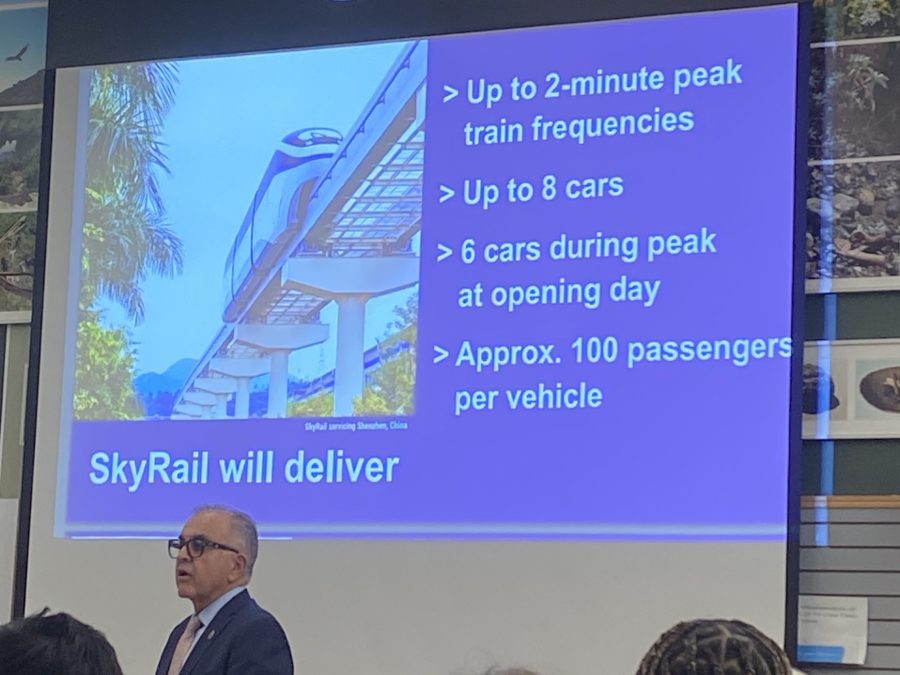Plans to connect the San Fernando Valley with Westside Los Angeles via public transportation and provide new options to underserved areas along the way continue to be contentious for supporters of dueling methods of transit.
The Sepulveda Transit Corridor project will connect the Valley to the Westside by navigating the natural barrier of the Santa Monica Mountains.
LA Metro wants to connect the two regions by railway by either tunneling underground or following roughly the same path as the 405 Freeway.
Six options are on the table, with each varying in total cost, transit time, amount and location of stops along the route, and whether the vehicles are automated or operated by a driver.
But what type of railway to build is proving to be the big hot-button issue.
On Thursday, a meeting meant to promote one of the possible solutions was crashed, respectfully, by supporters of the other.
Of the six project proposals, three use traditional heavy-rail trains like subways, while the other three utilize a novel transportation method beloved by Walt Disney: monorail.
The Sherman Oaks Neighborhood Council hosted LA SkyRail Express, the contractor chosen for the monorail options, to promote their vision of the project and answer community questions regarding the three proposals.
The packed meeting was held at the Martin Pollard Branch Library and began with a warning by the council: they were only there to discuss the monorail proposals, any other questions or comments would need to be held for another day.
During the 30-minute presentation, the project manager and a company spokesperson attempted to sell the benefits of monorail.
They can be be built faster, they said, because much of the construction is modular. The pillars can span over streets meaning major roadway modifications wouldn’t be needed. And because they are elevated and highly visible, the monorail “markets itself,” reminding both L.A. residents and the city’s visitors about public transportation options.

Some homeowners in Sherman Oaks, as well as wealthy neighborhoods like Bel Air, are in favor of the monorail options for various reason. In the Valley, some residents have voiced concerns about noise from full-blown trains operating at elevation — monorails are naturally quieter because they use rubber wheels. Of note, not all heavy-rail alternatives would have these trains operating on elevated platforms.
Some wealthy homeowners in Bel Air have tried to kill any underground tunneling beneath their homes, instead throwing their weight behind the monorail, which would operate mostly within the right-of-way of the 405 Freeway.
The monorails would be automated, offering up to eight cars during peak hours, carrying about 100 passengers with departures every two minutes.
Many of those in attendance grew visibly anxious as the presentation went on. After the council was given the first crack at questions, there was a rush to get comment cards in before meeting time expired.
While the council urged the public to keep their comments and questions focused on the monorail options so that questions could be directed to the people best suited to answer them, little interest was given to LA SkyRail Express or any of the three monorail proposals.
Transit activists have made it clear that heavy-rail is their preferred option. During public comment, they made that stance clear.
Questions about safety, capacity and station alignment were all voiced as concerns by those who were able to get their questions and comments in during the time allotted.
One speaker criticized the project team for prioritizing a rail stop at the Getty Center, while a dedicated station at UCLA is only present in one of the three monorail alternatives.
“I can’t support this project, I want something that’s going to get me as fast I can to the places I need to go. This project, as it’s designed, quite frankly, is designed for tourists,” he said.
Matthew Harris, a Pasadena resident and regular transit user, spoke about his concerns about mechanical issues on the suspended railways, citing a recent tire blowout at Disney World’s famous monorail that left passengers stranded for more than 80 minutes and required the entire vehicle to be evacuated.
“It’s more than just an inconvenience, it’s an accessibility issue,” Harris told KTLA after the meeting concluded.
Another speaker fought back tears as he described the challenges of having to walk long distances to make transfers due to the alignment of stations.
He urged LA Metro, who had a representative present to observe, to invest in the heavy rail option or nothing at all.
“This is an investment for 200 years,” he said.
The three heavy rail alternatives have won over many transit activists due to their faster commute times and increased capacity.
All three subway options are estimated to take about 20 minutes to traverse the entire line while carrying more than 100,000 people daily. Monorail, meanwhile, is estimated to take about 30 minutes, while carrying about 60,000 people daily.
Two of the heavy-rail options would utilize automated vehicles, while the third would be operated by a driver.
The automated trains would arrive three cars at a time every 2.5 minutes and would carry 170 people during peak hours. Driver-operated trains would arrive six cars at a time, carrying 133 people during peak hours and depart every four minutes.
While supporters of the heavy rail options have their own qualms with the three proposals that utilize their preferred method of transportation, one thing they seem to be in agreement with is that the monorail is a nonstarter.
Currently, LA Metro already uses heavy rail along the B Line and D Line and some supporters say that method is working just fine and is more equipped to handle the evolving landscape of Los Angeles and the ever-changing demands of its residents.
“Why reinvent the wheel?” Harris said. “I think they are looking for a problem to solve.”
For a detailed breakdown of all six of the Sepulveda Transit Corridor alternatives, click here.











